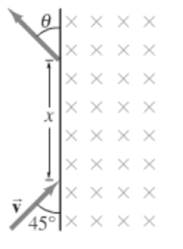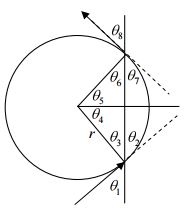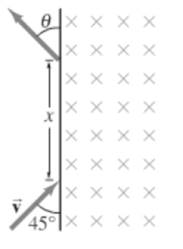
Concept explainers
(a)
The angle of leaving.
(a)
Answer to Problem 25P
The angle at which proton leaves is
Explanation of Solution
Given:
The proton enters from a field-free region into the uniform magnetic field and then leaves in the same.
The angle at which proton enters is
Magnetic field is 0.850 T.

Calculation:
Consider the figure shown below.

Since a proton is making a curve which when extended forms a circle and the distance
Conclusion:
The angle at which proton leaves is
(b)
The distance of proton to exit the field.
(b)
Answer to Problem 25P
The distance
Explanation of Solution
Given:
The proton enters from a field-free region into the uniform magnetic field and then leaves in the same.
The angle at which proton enters is
Magnetic field is 0.850 T.

Formula Used:
The radius of the particle in the magnetic field is calculated as
Calculation:
The distance
Conclusion:
The distance
Chapter 20 Solutions
Physics: Principles with Applications
Additional Science Textbook Solutions
University Physics (14th Edition)
College Physics: A Strategic Approach (4th Edition)
Physics (5th Edition)
University Physics Volume 1
Tutorials in Introductory Physics
The Cosmic Perspective (8th Edition)
 College PhysicsPhysicsISBN:9781305952300Author:Raymond A. Serway, Chris VuillePublisher:Cengage Learning
College PhysicsPhysicsISBN:9781305952300Author:Raymond A. Serway, Chris VuillePublisher:Cengage Learning University Physics (14th Edition)PhysicsISBN:9780133969290Author:Hugh D. Young, Roger A. FreedmanPublisher:PEARSON
University Physics (14th Edition)PhysicsISBN:9780133969290Author:Hugh D. Young, Roger A. FreedmanPublisher:PEARSON Introduction To Quantum MechanicsPhysicsISBN:9781107189638Author:Griffiths, David J., Schroeter, Darrell F.Publisher:Cambridge University Press
Introduction To Quantum MechanicsPhysicsISBN:9781107189638Author:Griffiths, David J., Schroeter, Darrell F.Publisher:Cambridge University Press Physics for Scientists and EngineersPhysicsISBN:9781337553278Author:Raymond A. Serway, John W. JewettPublisher:Cengage Learning
Physics for Scientists and EngineersPhysicsISBN:9781337553278Author:Raymond A. Serway, John W. JewettPublisher:Cengage Learning Lecture- Tutorials for Introductory AstronomyPhysicsISBN:9780321820464Author:Edward E. Prather, Tim P. Slater, Jeff P. Adams, Gina BrissendenPublisher:Addison-Wesley
Lecture- Tutorials for Introductory AstronomyPhysicsISBN:9780321820464Author:Edward E. Prather, Tim P. Slater, Jeff P. Adams, Gina BrissendenPublisher:Addison-Wesley College Physics: A Strategic Approach (4th Editio...PhysicsISBN:9780134609034Author:Randall D. Knight (Professor Emeritus), Brian Jones, Stuart FieldPublisher:PEARSON
College Physics: A Strategic Approach (4th Editio...PhysicsISBN:9780134609034Author:Randall D. Knight (Professor Emeritus), Brian Jones, Stuart FieldPublisher:PEARSON





